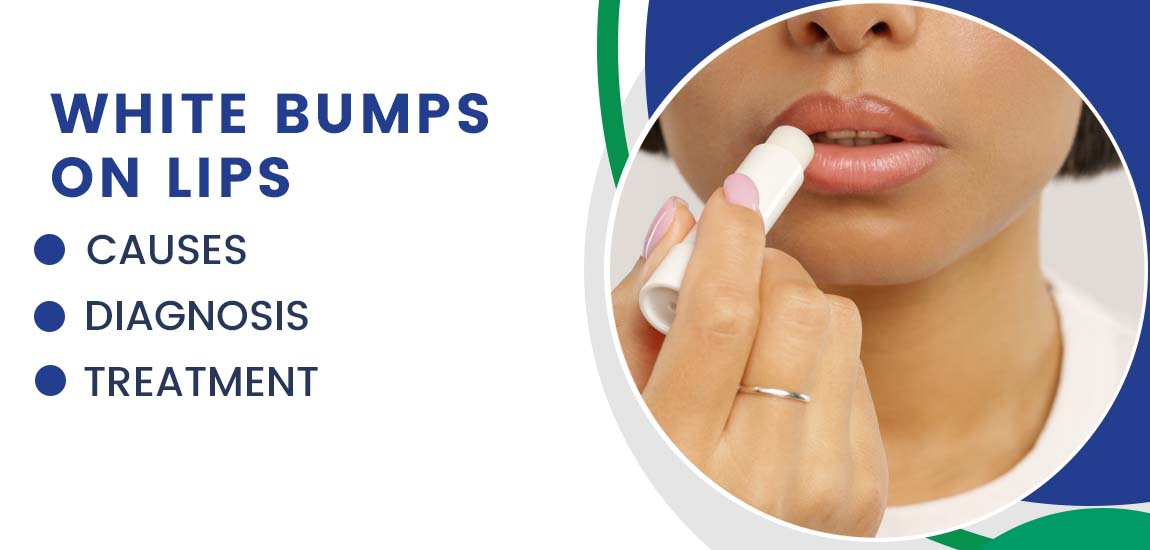
- By JRSH Admin
- In Health and Tips,
- Posted November 14, 2022
White Bumps on Lips: Causes, Diagnosis, and Treatment
The sudden changes in your lips can be difficult to ignore, whether you're glancing in the mirror after waking up or applying your favorite lip balm. If you have a bump on your lip, you might wonder what it is and where it came from. The sudden spot on or around your lips could have been caused by a number of factors.
What are the White Bumps on your Lips?
In most cases, white bumps on the lips are harmless, and there are a variety of reasons why they can appear. Although generally benign, white bumps on the lips may cause concern under certain circumstances.
The color and texture of your skin change, for example, can be a sign of something wrong. You can tell a lot about your overall health from the bumps on your lips, particularly if they are painful or uncomfortable.
In order to prevent these white bumps from causing you problems, you must diagnose them early and treat them sooner rather than later.
Causes of White Bumps on Lips:
Lip bumps can be small or large, different colors or textures. The causes of this condition can range from acute to chronic. Lip bumps are caused by a variety of factors, such as:
- Cold sores or canker sores
- White spots caused by Fordyce granules, which are harmless
- Hand, foot, and mouth disease
- Allergic reaction
- Bacterial infections
- Small benign cysts, or "milk spots", called milia
- The mucoceles are bumps that form when the salivary glands are blocked
- Oral herpes
- Oral thrush
- Oral cancer
- The condition of perioral dermatitis is caused by irritation of the skin around the mouth
Despite the fact that many lip bumps are harmless, conditions such as oral cancer can cause serious health problems.
Types of White Bumps on Lips:
There are various types of white bumps on the lips which has been shown below:
1. Fordyce Spots
There are small white or yellow patches on or around the lips. Patches like these fade with time, are not contagious and are neither painful nor contagious. There are enlarged sebaceous glands, which usually occur on the lips, or on the mucosa of the mouth.
Penis, scrotum, and labia can also develop these lesions, although they are less common. People in their middle age and elderly are more likely to suffer from this condition. According to a study, individuals with an elevated lipid profile may have the highest Fordyce spot score.
2. Milia
These skin-surface keratine cysts are benign (meaning they are not harmful) and temporary. Cysts are created when dead skin cells become entrapped beneath the skin. These cysts commonly appear on the face in infants, most frequently on the cheeks, chin, nose, or lip line.
Primary milia and secondary milia are the two categories under which milia are categorized. Some milia's lesions disappear on their own, but not all do. However, they are manageable with topical retinoids and straightforward surgical procedures.
3. Oral Thrush
It is an infection brought on by an overgrowth of Candida albicans fungus in the mouth. Oropharyngeal candidiasis and oral candidiasis are other names for the condition, which affects the oral mucosa. White or yellowish bumps on the inside of the cheeks, lips, and tongue are its defining features.
4. Canker Sores
The mucous membrane lining the mouth has these inflammatory white-reddish patches, also known as mouth ulcers. Canker sores typically appear in pairs or groups of four. Many people begin to experience them as teenagers or young adults.
Women experience these more frequently than men do. Canker sores are uncomfortable but not contagious, and they usually go away in a week or so. They can be triggered by stress, oral injuries, and foods like coffee, peanuts, and tomatoes.
5. Mucoceles
The most frequent lesions of the oral mucosa are mucoceles. These are brought on by an overproduction of mucus due to injury, a propensity for lip-biting, or modifications in the small salivary glands. These can develop on the lips (which are the most typical), cheeks, or mouth, as well as anywhere else in the oral mucosa.
6. Oral Cancer
It is characterized by a flat, white bump in the mouth brought on by a number of things, such as excessive sun exposure, drinking too much alcohol, smoking, and the human papillomavirus (HPV). The HPV virus is transmitted from person to person through skin-to-skin contact.
7. Hand, Foot, and Mouth Disease (HFMD)
Children under the age of five are frequently affected by this viral infectious condition. It displays a number of uncomfortable symptoms, including a loss of appetite, a rash on the fingers, soreness and red spots in the mouth, etc.
8. Perioral Dermatitis
This is a skin condition that frequently develops around the mouth and resembles a rash. It has been discovered that it happens for some people when allergic reactions are triggered by specific cosmetic appliances and toothpaste that contains fluoride.
How to Diagnosis White Bumps on lips?
A physical examination of the bumps on and inside of your lips is performed after your medical history has been obtained. The neck and lymph nodes will be examined for any swelling.
In order to determine whether bacteria, viruses, or fungi are the source of the bumps on your lips, your doctor may take a culture from them. Blood tests are used to determine whether the herpes virus is the root cause of the problem.
A tissue sample from the lips is taken and examined for the presence of cancerous cells in the event that oral cancer is suspected.
Treatment for White Bumps on Lips:
When determining the underlying cause of lip bumps, it is important to review the patient's medical history to determine whether certain medications, inherited conditions, allergens, or other factors are to blame. For the diagnosis of some conditions, blood tests, MRI scans, and skin cell testing may be required.
Depending on the cause, different treatments are used for swollen bumps on the lips. The following are the most typical medications for treating this condition:
- If the issue is brought on by infectious conditions, antiviral and antifungal medications are recommended.
- Antihistamine medications will address the problems if the bumps are caused by allergic reactions or inflammatory conditions.
- Pain relievers, OTC medications, and creams are advised if the bump on the lips occurs with oral conditions like canker sores.
- If the underlying cause is more complicated, additional cutting-edge procedures like electrosurgery or laser treatments may be used.
Home Remedies of White Bumps on Lips:
Here are a few self-care home remedies that could hasten the healing process and lessen any pain or discomfort associated with a lip bump.
- Once the bump has disappeared, wash your face with warm water. Make use of a liquid cleaner.
- After washing the face, pat the skin dry rather than rubbing it.
- Avoid the use of tobacco.
- Avoid using face creams, sunscreen, and cosmetics.
- Consume a diet high in whole-food-based vitamins and minerals.
- Be sure to hydrate yourself.
- Do not touch, squeeze, or rub the bumps.
- Brushing and flossing your teeth at least twice a day will help you maintain good oral health.
- Use lip balms with natural ingredients and a factor to protect yourself from the sun.
When to See a Doctor?
The majority of lip bumps are not dangerous, and a lot of them go away on their own without any kind of care. Nevertheless, a person needs to see a doctor if they have:
- lip bumps that haven't gone away for a few weeks
- itchiness or annoyance of bumps
- a swollen mouth or face
- issues with breathing or swallowing
- lumps in the mouth, lips, or gums
- bleeding, discomfort, or numbness in the mouth, lips, or gums
- loss of teeth
- voice variations
- soreness in throat
- a rash that spreads rapidly
Tags
Blog Search
Latest Posts
-
Dark Circles Under The Eyes: Causes, Home Remedies and Treatments
December 21, 2025 -
बर्ड फ्लू के लक्षण, कारण, उपचार और बचाव के उपाय जानें
December 04, 2025 -
Best Diet Plan for Menopause Weight Management
November 25, 2025 -
Pulmonary Fibrosis Treatment: Understanding Lung Scarring and Breathing Problems
November 21, 2025 -
Arrhythmia: Types, Causes, Symptoms, and Treatment
November 07, 2025



